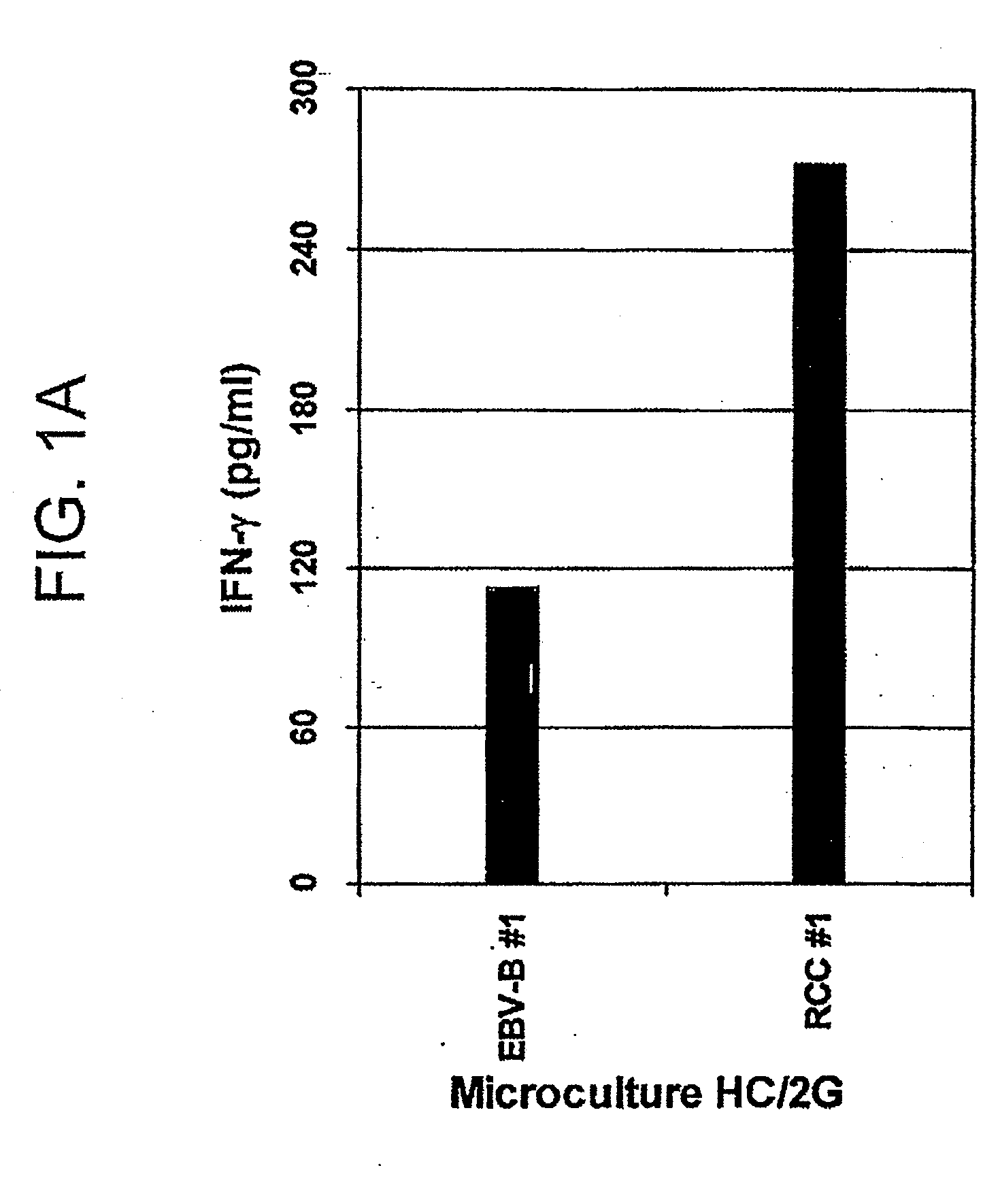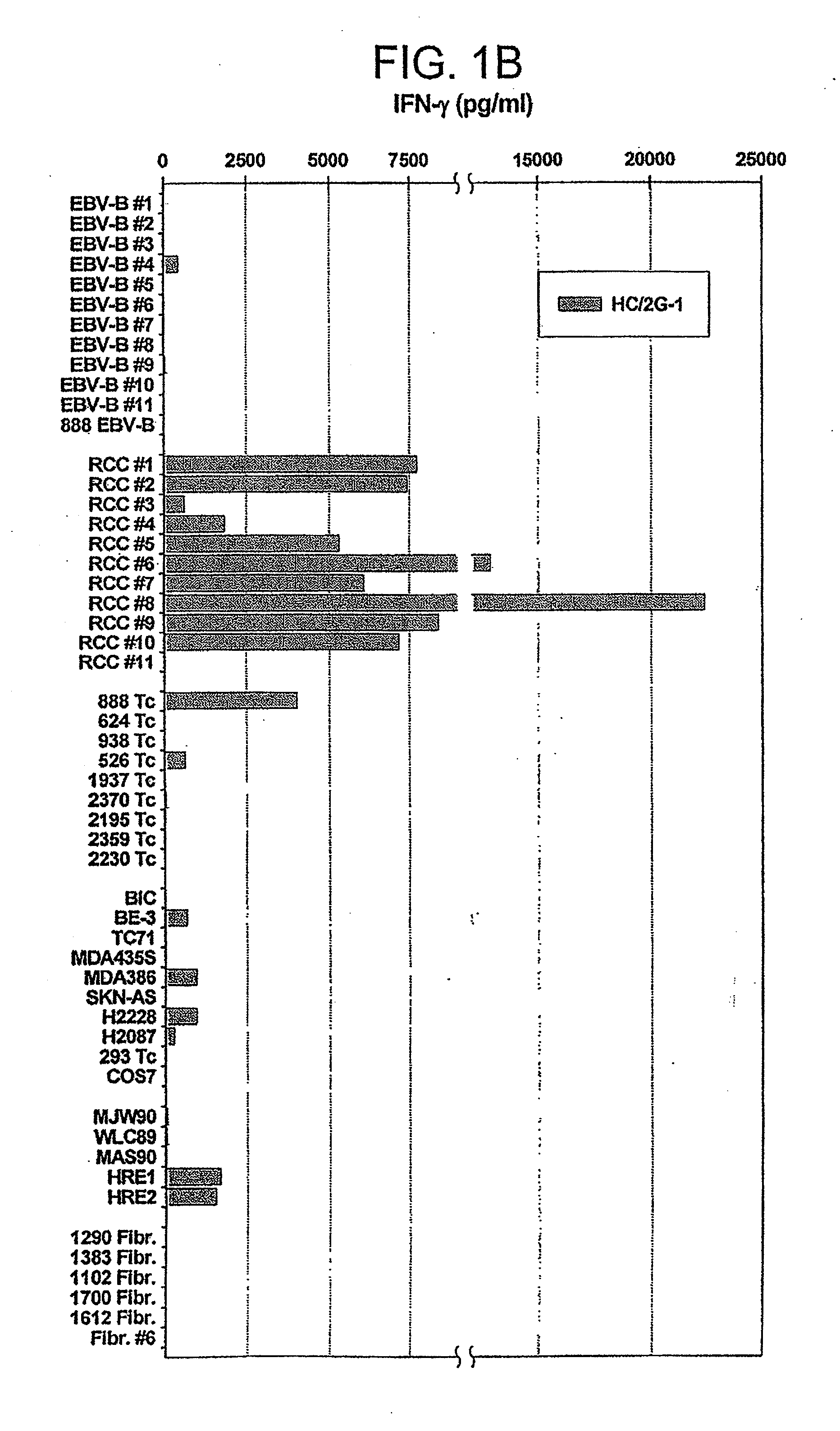T cell receptors and related materials and methods of use
a technology of receptors and t cells, applied in the field of t cell receptors, can solve the problems of few successful examples of generating rcc-reactiv
- Summary
- Abstract
- Description
- Claims
- Application Information
AI Technical Summary
Benefits of technology
Problems solved by technology
Method used
Image
Examples
example 1
[0139]This example demonstrates a method of making a T cell clone having antigenic specificity for a renal cell carcinoma antigen and demonstrates the biological activity of that clone.
[0140]To establish RCC-specific T cells, CD8+- and / or CD4+-enriched T cells (Miltenyi Biotec Inc, Auburn, Calif.) were stimulated with Day 6 dendritic cells (DCs) co-cultured with UV-irradiated autologous tumor cells, as described previously with some modifications (Wang et al., 2005, supra). Briefly, CD 14+ DCs were isolated from patient peripheral blood mononuclear cells (PBMC) using CD14 microbeads according to the manufacturer's instructions (Miltenyi Biotec Inc. Auburn, Calif.), and cultured in RPMI 1640 supplemented with 10% human serum (HS; Valley Biomedical Inc. Winchester, Va.), GM-CSF (1000 U / ml; Peprotech, Rocky Hill, N.J.), and IL-4 (1000 U / ml; Peprotech) for 6 days to generate monocyte-derived DCs (herein referred to as Day 6 DCs). To stimulate T cells, Day 6 DCs were co-cultured with UV-...
example 2
[0146]This example demonstrates a characterization of T cell clone HC / 2G1.
[0147]HC / 2G-1 T cell clones were stained with the FITC- and PE-labeled anti-human MoAbs described above, and analyzed by FACScan. As shown in FIGS. 2A and 3A, the T cell clones were positive for expression of TCR α and β chains, CD3, CD4, and CD56 and negative for expression of CD16, CD57, CD161, and TCR γ and δ chains.
[0148]HC / 2G-1 T cell clones (1×104 per well) were co-cultured with autologous tumor cells (RCC#1 and EBV-B#1) or allogeneic tumor cells (RCC#11 and EBV-B #11) overnight, and the supernatant was collected and tested for cytokine secretion by SearchLight™ (Pierce Biotechnology, Inc., Rockford, Ill.). As a control, HC / 2G-1, EBV-Bs and RCCs cultured alone were also included in the assay. As shown in FIG. 2B, HC / 2G-1 T cell clones secreted multiple cytokines upon stimulation with autologous RCC cells. In contrast, HC / 2G-1, EBV-Bs and RCCs cultured alone showed no or very little cytokine secretion (da...
example 3
[0149]This example demonstrates that the activity of HC / 2G-1 T cell clones was mediated through the TCR and was independent of MHC molecules of HLA Class I and HLA Class II.
[0150]Autologous RCC cells (RCC#1; 5×104 cells in 100 μl ) were incubated with each blocking mAb (anti-HLA class I, anti-HLA class II, anti-TCRα / β and anti-CD4) at the concentration of 10 μg / ml for 30 min at 37° C. in a flat-bottom 96-well plate. HC / 2G-1 T cells (1 to 5×104 cells / well) were then added and incubated with target cells overnight at 37° C. As a control, HLA-B44-restricted CTL clone (MW / 5H-5) and HLA-class II-restricted CD4+ T cell clone (HC / 10C-3) were co-cultured with their autologous tumors. The supernatants were harvested and assayed for IFN-γ concentration by ELISA.
[0151]As shown in FIG. 3B, the reactivity of HC / 2G-1 T cell clones was blocked by anti-TCR antibodies, not blocked by anti-HLA Class II antibodies, and partially blocked by anti-HLA Class I antibodies. In contrast, the anti-HLA Class I...
PUM
| Property | Measurement | Unit |
|---|---|---|
| temperatures | aaaaa | aaaaa |
| time | aaaaa | aaaaa |
| concentration | aaaaa | aaaaa |
Abstract
Description
Claims
Application Information
 Login to View More
Login to View More - R&D
- Intellectual Property
- Life Sciences
- Materials
- Tech Scout
- Unparalleled Data Quality
- Higher Quality Content
- 60% Fewer Hallucinations
Browse by: Latest US Patents, China's latest patents, Technical Efficacy Thesaurus, Application Domain, Technology Topic, Popular Technical Reports.
© 2025 PatSnap. All rights reserved.Legal|Privacy policy|Modern Slavery Act Transparency Statement|Sitemap|About US| Contact US: help@patsnap.com



